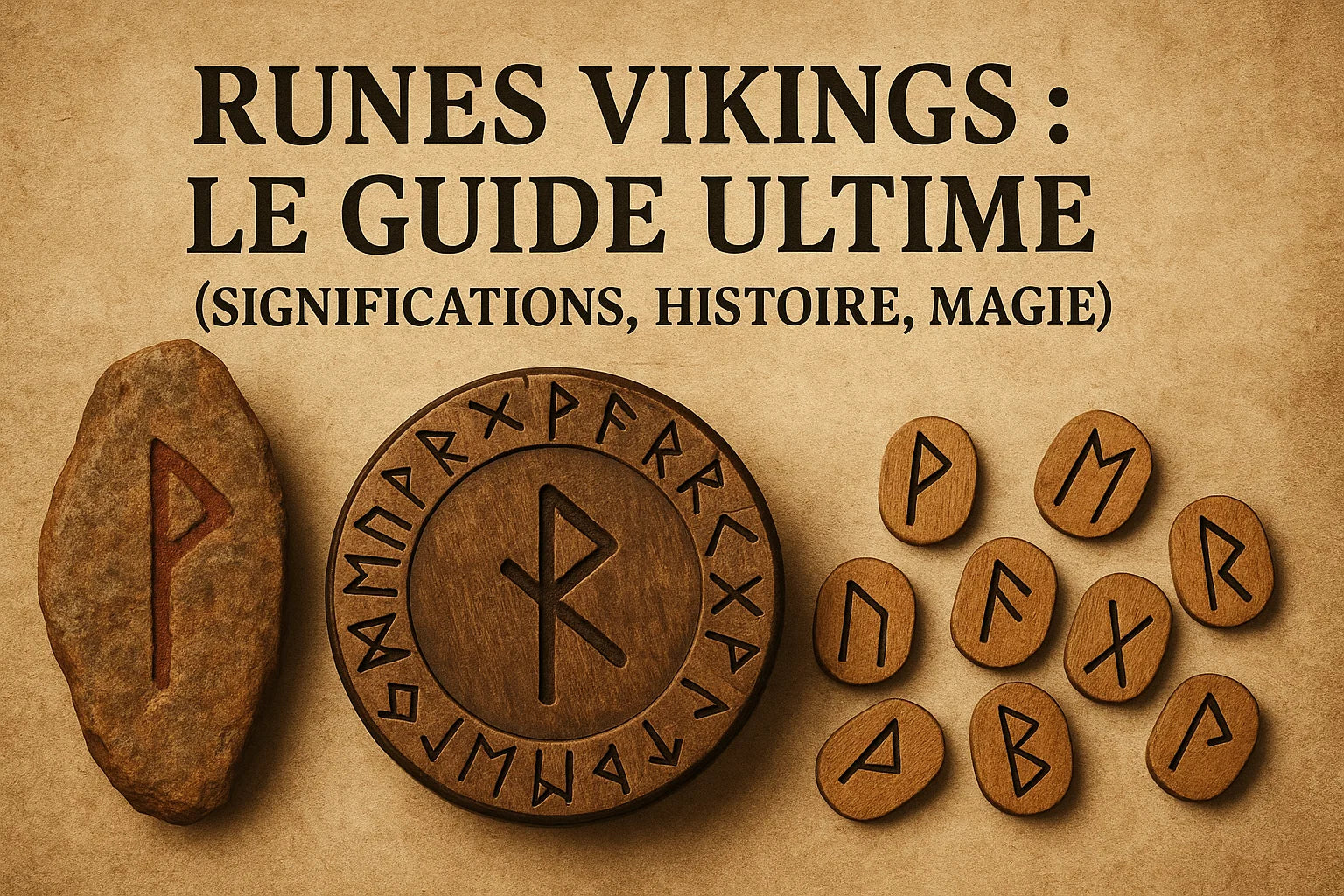Introduction
Imagine a world where each engraved symbol carries within it a secret, a strength, an echo of the gods and ancestors. This is the world of Viking runes, much more than a simple alphabet. These angular markings, chiseled in stone, wood, or metal, were the language of spirituality, magic, and wisdom for the Norse peoples. Let's dive together into the fascinating world of Viking runes, from their mysterious origins to their powerful meaning today.
What is a Viking Rune? Definition and Role
A rune is a character belonging to an ancient writing system used by Germanic and Norse peoples from the first centuries AD. Viking runes, specifically associated with the Viking Age (c. 793–1066 AD), are recognizable by their straight, angular shapes, designed to be easily engraved.
But runes weren't just a tool for written communication. Each rune carried deep symbolic meaning, often linked to elements of nature, abstract concepts, or cosmological forces from Norse mythology. They were seen as bearers of power and mystery, used in ritual, magical, and divinatory contexts, in addition to their everyday scriptural use.
The Origins and Fascinating History of Runes
The exact origin of runes remains a subject of debate among historians and runologists. The most popular theory suggests that they derived from Mediterranean alphabets (probably Italic scripts) and were adapted by Germanic peoples around the 1st or 2nd century AD to create a writing system suitable for engraving.
The oldest runic inscriptions date back to this period. Over the centuries, as Germanic languages evolved and peoples moved, the runic alphabet transformed, giving rise to different regional versions. The Viking Age saw the peak and also a simplification of this alphabet with the appearance of the Younger Futhark.
The Runic Alphabet: The Futhark and its Evolutions
The Elder Futhark: The Original Alphabet (24 Runes)
Used from approximately the 2nd to the 8th century AD, the Elder Futhark is the oldest and most complete form of the runic alphabet, comprising 24 distinct characters. It is structured into three groups of eight runes, called Aettir (or Ættir), each associated with a deity or mythological concept (usually Freyja/Freyr, Heimdall, and Týr). It is this alphabet that is most often studied today for its rich symbolism and used in modern divination or spiritual practices.
The Younger Futhark: The Viking Age Alphabet (16 Runes)
Appearing around the 8th century and used throughout the Viking Age (until about the 12th century), the Younger Futhark is a simplified version of the Elder Futhark, containing only 16 runes. This reduction in characters to transcribe an evolving language made writing more ambiguous, as a single rune could represent multiple sounds. There are several regional variants of the Younger Futhark, such as the Danish Futhark, the Swedish-Norwegian Futhark (or Short-stem Futhark), and the Icelandic Futhark.
The Anglo-Saxon Futhorc: The Alphabet in England (more runes)
Another variant developed in Frisia and England, the Anglo-Saxon Futhorc, which saw its number of runes increase over time to as many as 33 characters to better represent the changing sounds of Old English.
Although the Younger Futhark was the one used during the Viking Age, the Elder Futhark remains the standard for studying the deeper symbolic and spiritual meaning of the runes, as each character has a more distinct sound-symbol correspondence and richer conceptual associations.
The Complete Elder Futhark: Detailed Meaning of the 24 Runes
Let's now explore the meaning of each of the 24 runes of the Elder Futhark. Each rune is an archetype, a portal to key concepts in the Norse worldview.

First Aett - The Aett of Freyja (or Freyr): The Material and Original World
This first group is often associated with primordial aspects, wealth, basic needs and creative forces.
Fehu (Fé)
Symbol : ᚠ
Phonetic value : F
Literal meaning : Livestock, Mobile wealth
Symbolic/Divinatory Meaning : Represents abundance, material and spiritual prosperity, achieved success, fertility, and energy in motion. It is linked to wealth not only in goods, but also in personal power.
Uruz (Ur)
Symbol : ᚢ
Phonetic value : U
Literal meaning : Aurochs (wild ox), Primal Force
Symbolic/Divinatory Meaning : Symbolizes raw, untamed strength, vitality, physical health, endurance, courage, and unmanifested potential. It evokes the wild forces of nature and the power of survival.
Thurisaz (Thorn)
Symbol : ᚦ
Phonetic value : Th (as in "thorn")
Literal meaning : Thorn, Giant (Thurs), Thor's Hammer
Symbolic/Divinatory Meaning : A rune of reactive strength, often associated with challenges, obstacles, but also with protection through confrontation (like a defensive thorn or Thor's protective hammer). It represents chaotic forces but also the ability to overcome them.
Ansuz (As)
Symbol : ᚨ
Phonetic value : A
Literal meaning : God (Aesir), Mouth, Word, Divine Breath
Symbolic/Divinatory Meaning : Associated with communication, inspiration, wisdom, and spiritual authority. It represents the divine voice, transmitted knowledge, learning, messages, and signs. Often associated with Odin.
Raidho (Rad)
Symbol : ᚱ
Phonetic value : R
Literal meaning : Chariot, Journey, Path
Symbolic/Divinatory Meaning : Symbolizes movement, journey (physical or spiritual), orderly progress, good advice, cosmic rhythm, quest. It represents structure and direction in life.
Kaunan (Kenaz)
Symbol : ᚲ
Phonetic value : K (or hard C)
Literal Meaning : Torch, Ulcer, Knowledge
Symbolic/Divinatory Meaning : Represents light, knowledge, illumination, creativity, passion, healing (like a cautery). It is the light that reveals, guides, and allows one to see clearly.
Gebo (Gifu)
Symbol : ᚷ
Phonetic value : G
Literal meaning : Gift, Donation, Partnership
Symbolic/Divinatory Meaning : Symbolizes exchange, giving and receiving, balanced relationships, and partnerships (romantic, friendly, and business). It represents generosity and mutual bonds that bring strength and harmony. It is the only rune without an inverted position.
Wunjo (Wynn)
Symbol : ᚹ
Phonetic value : W (or V)
Literal meaning : Joy, Happiness, Pleasure
Symbolic/Divinatory Meaning :
It embodies harmony, euphoria, and emotional well-being. Wunjo is a rune of unity, family, and collective success. It is the rune of authentic joy, deep satisfaction, and inner balance.
Second Aett - Heimdall's Aett: Identity, Challenges, and Destiny
This group explores the fundamental elements of the human condition: trials, cycles, introspection, and inner growth.
Hagalaz (Hagl)
Symbol : ᚺ (or ᚽ)
Phonetic value : H
Literal meaning : Hail
Symbolic/Divinatory Meaning :
A rune of natural chaos, Hagalaz evokes ruptures, sudden storms, and inevitable upheavals. But like hail that nourishes the earth after its passage, it also carries within it the potential for transformation.
Nauthiz (Naud)
Symbol : ᚾ
Phonetic value : N
Literal meaning : Necessity, Distress
Symbolic/Divinatory Meaning :
It reflects limitations, deprivation, and tension. Nauthiz is an invitation to draw on one's inner strength to overcome constraints and transform needs into an engine of growth.
Isa (Is)
Symbol : ᛁ
Phonetic value : I
Literal meaning : Ice
Symbolic/Divinatory Meaning :
Isa symbolizes freezing, stillness, and introspection. She freezes a situation to invite reflection and clarity. In a reading, she calls for patience and refocusing.
Jera (Jer)
Symbol : ᛃ
Phonetic value : J or Y
Literal meaning : Year, Harvest
Symbolic/Divinatory Meaning :
A rune of the natural cycle, Jera evokes time, merit, and just reward. It represents the fruits of past labor, a period of harmonious transition.
Eihwaz (Eoh)
Symbol : ᛇ
Phonetic value : Ei
Literal meaning : Yew (sacred tree)
Symbolic/Divinatory Meaning :
The tree of endurance and transformation. It connects the world of the living to that of the dead. It is a rune of resilience, spiritual journeying, and persistence.
Perthro (Peorth)
Symbol : ᛈ
Phonetic value : P
Literal meaning : Mystery, Destiny
Symbolic/Divinatory Meaning :
Perthro embodies the unknown, the secret of destiny, and luck. It is the rune of future revelations, synchronicities, and the play of invisible forces.
Algiz (Eolh)
Symbol : ᛉ
Phonetic value : Z
Literal meaning : Protection
Symbolic/Divinatory Meaning :
A defense rune, Algiz protects against danger. It evokes intuition, instinct, divine blessings, and the ability to connect with the sacred to strengthen oneself.
Sowilo (Sigel)
Symbol : ᛋ
Phonetic value : S
Literal meaning : Sun
Symbolic/Divinatory Meaning :
Sowilo is solar energy, success, and inner light. It brings vitality, clarity, and triumph. It also symbolizes integrity and revealed truth.
Third Aett - The Aett of Týr: Justice, Spirit and Heritage
This latter group is oriented towards collective responsibilities, ethical codes, spirituality and ancestral ties.
Tiwaz (Shooting)
Symbol : ᛏ
Phonetic value : T
Literal meaning : God Týr, Justice
Symbolic/Divinatory Meaning :
Tiwaz is a symbol of noble sacrifice, honor, and a sense of duty. She embodies the quest for a goal greater than oneself, guided by fairness.
Berkana (Beorc)
Symbol : ᛒ
Phonetic value : B
Literal meaning : Birch, Growth
Symbolic/Divinatory Meaning :
Berkana is the nurturing mother. She supports beginnings, the protection of the home, healing, and gentle evolution.
Ehwaz (Eh)
Symbol : ᛖ
Phonetic value : E
Literal meaning : Horse
Symbolic/Divinatory Meaning :
This rune evokes alliance, loyalty, mobility, and the symbiosis between partner and mount. It indicates a harmonious journey and an evolution based on trust.
Mannaz (Man)
Symbol : ᛗ
Phonetic value : M
Literal meaning : Humanity
Symbolic/Divinatory Meaning :
Rune of the individual and the community. It represents human consciousness, mutual aid, and collective intelligence. It calls for introspection and cooperation.
Laguz (Lagu)
Symbol : ᛚ
Phonetic value : L
Literal meaning : Water
Symbolic/Divinatory Meaning :
Laguz is fluid and intuitive. It symbolizes emotions, dreams, and inner life. It guides emotional cycles and helps navigate the depths of one's being.
Inguz (Ing)
Symbol : ᛜ
Phonetic value : NG
Literal meaning : Fertility, Potential
Symbolic/Divinatory Meaning :
Inguz represents the seed ready to germinate. It is the rune of the completion of a cycle and the release of creative energy.
Othala (Othel)
Symbol : ᛟ
Phonetic value : O
Literal meaning : Heritage, Inheritance
Symbolic/Divinatory Meaning :
It symbolizes anchoring, roots, and transmitted values. It is the rune of ancestors, inherited lands, and family stability.
Dagaz (Dag)
Symbol : ᛞ
Phonetic value : D
Literal meaning : Day, Dawn
Symbolic/Divinatory Meaning :
Dagaz is transformation, sudden clarity, illumination. It evokes breakthroughs, new opportunities, and inner revolutions.
Runes, Magic and Norse Mythology
The connection between runes, magic, and Norse mythology is inextricable. In the myths, it was the chief god Odin who acquired knowledge of the runes by sacrificing himself and clinging to the world tree Yggdrasil for nine days and nine nights. This myth emphasizes their sacred nature and their deep connection to wisdom and cosmic forces.
Runes were considered keys to understanding and influencing Wyrd (destiny, or the interconnected set of past, present, and future actions). Magical practice involving runes was often called Seiðr, although runes could also be used in more direct forms of magic, such as runebinding (the creation of symbols combining multiple runes for a specific purpose) or carving them into objects to imbue them with power. Each rune embodied an aspect of reality and could be invoked or used to channel that energy.
The Historical Use of Viking Runes

Runes had various uses in Viking society:
- **Commemorative Inscriptions:** Their most famous uses are runestones, erected to commemorate individuals, events, or claim land. They provide valuable information about Viking history, society, and language.
- **Everyday Objects:** Runes were carved into combs, jewelry, tools, weapons, and other personal items, sometimes to mark ownership, sometimes for protection or good fortune.
- **Short Messages:** Although wood or other perishable materials were more common, runes were also used for short communications or business messages.
- **Magic and Rituals:** As mentioned, they were used in amulets, talismans, charms, and rituals for protection, healing, success in battle, or other purposes.
Viking Runes Today: Heritage and Inspiration
Today, interest in Viking runes is stronger than ever. Far from being mere relics of the past, they continue to inspire:
- **In Popular Culture:** Movies, TV shows (like Vikings), video games, and literature feature them, often with a touch of mysticism.
- **In Art and Fashion:** Runic symbols and rune-inspired designs are popular in tattoos, jewelry (rings, pendants), clothing, and decor. Many choose to wear a specific rune for its personal meaning (protection, strength, joy).
- **In Spiritual Practices:** Many people today use runes for divination (rune casting), meditation, or as part of neo-pagan or reconstructionist beliefs related to Norse spirituality. They serve as a tool for introspection and connection with ancestral archetypes.
This popularity is a testament to the enduring power and symbolic richness of Viking runes, which continue to speak to those seeking a connection to history, mythology, and the deeper forces of existence.
Discover our Viking Runes Jewelry
Express your passion for runes and Norse mythology with our beautiful rings and pendants. Each piece of jewelry carries the power and wisdom of the runes.
See the Rune Collection


